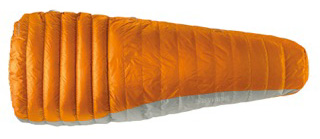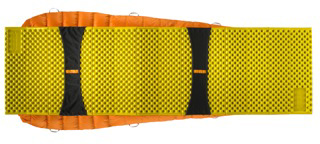During a weeklong trip in Alaska this fall, I camped out every night, explored forests and mountains, and cooked meals beside a roaring fire. It was a perfect setting to test a few new products, including Therm-A-Rest’s Navis sleeping bag.
The unique “headless” bag is a 2013 model and not yet on sale. Watch for it in stores later this winter for $250.
At 1lb, 5oz, the bag falls in the ultra-light category and is aimed at backpackers.

Why no hood? To save weight, of course. The theory is a hood is not needed if you have a warm jacket to wear to bed, which many backpackers bring anyway.
There is no zipper — you just slither in from the top. The bag also has no insulation on its bottom, requiring a sleeping pad to keep you warm on the ground.
Large elastic loops hold a pad and the bag firmly together, and a thin drawstring cinches the bag at the shoulders to keep in the warmth.
Brands like Big Agnes and GoLite have sold similar “hood-less” bag styles for years. The Navis offers a “universal” mattress attachment, allowing it to function with several types of sleeping pads.
The Navis also has a normal, mummy-style shape, not a shape made to fit a specific sleeping pad. This allows it to be smaller and lighter than some similar designs.
Therm-A-Rest uses 750+ fill down for insulation. The bag is rated with a 25 – 45° F range, meaning any given camper will find a comfortable spot in that range. If you sleep cold, do not plan to use this bag at 25 degrees outside, in other words.

I found the setup to be warm in Alaska on nights where the temp was around freezing. I paired the Navis with a mid-weight puffy jacket and a hat on my head and slept like a champ.
Worth noting is the 2.5-inch thickness of the pad I used, the NeoAir ThermX. This inflatable camp mattress is lined with “reflective barriers” and retails for a cool $190.
At 14 ounces, the pad weighed nearly as much as the sleeping bag. But, no lie, aboard this cush setup I experienced hands-down the most comfortable sleep I’ve had in the woods, with a hood or without.
—T.C. Worley is a contributing editor.







